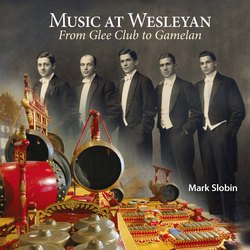Читать книгу Music at Wesleyan - Mark Slobin - Страница 8
На сайте Литреса книга снята с продажи.
ОглавлениеAuthor’s Note
Wesleyan has always been a remarkably musical campus. By the late 1800s, it was called the “Singing College.” The Glee Club toured regularly and extensively, earned positive reviews in the local presses of the hosting cities and towns, and won national awards. But the first faculty appointment in music did not arrive until the 1920s, and only two people taught music into the 1940s, rising to four by 1953.
The early 1960s saw a radical revolution in music that paralleled Wesleyan’s opening from men’s college to diverse university. A visionary program combining world music and experimental music vaulted Wesleyan to national and international prominence as a major center, unique among liberal arts colleges. Adding faculty to teach music from many cultures and a comprehensive graduate program, the department grew in numbers and in stature. Wesleyan’s Music Department’s undergrad alumni play in New York clubs, enter music graduate programs, compose film scores, teach music in many contexts, serve as state arts council chairs, foundation heads, or simply carry the joy and knowledge of music into their lives as a liberal arts legacy. Wesleyan’s Music Department M.A. and Ph.D. graduates hold faculty positions across the U.S. and abroad, from Indonesia to India, from Africa to Australia, from Canada to Switzerland.
This book consists of two parts: pre- and post-1960s music at Wesleyan. I have been privileged to take part in nearly 20% of this grand musical pageant, and have greatly enjoyed assembling this brief account. It draws on images from Wesleyan University’s Special Collections archives, for which I owe a huge round of thanks to its director, Suzy Taraba; to University photographer, John Wareham, for scans; and to music doctoral student, Jorge Arevalo Mateus, for researching Argus files. Bill Burkhart was enormously generous with photos; and Olivia Bartlett made the great suggestion of cleaning the North College plaques, to which John Meerts graciously acceded. I would like to thank Suzanna Tamminen and Leslie Starr of Wesleyan University Press for their instant embrace of celebrating the Wesleyan musical heritage, and foundational figure Richard Winslow for his informative and witty forays into department history.
All illustrations originated at Wesleyan, either from Special Collections or Public Information, so there are no specific caption credits. Most historical citations are from the student newspaper, the Argus (which tended not to feature bylines), unless otherwise indicated. I would like to thank the present and former faculty and students who offered the reminiscences quoted below. I would also like to thank Alec McLane and Dan Schnaidt for enabling the rich accompanying archive of online Wesleyan music over the decades. Copious thanks also go to Michael Roth for his generous support of this project.
To listen to performances of music at Wesleyan, you may access a selection of audio files at the companion digital archive for this book at http:wesscholar.wesleyan.edu/maw_audio/
